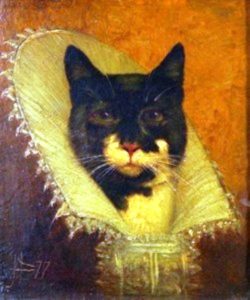
John Henry Dolph, “The Duchess”
“The leading cat-painter of America is Mr. J. H. Dolph, whom everyone knows, for his works appear constantly at exhibitions. He has worked and studied much abroad, at Paris, Antwerp, and Rome. Mr. Dolph excels in the delineation of feline and canine character.”–The Monthly Illustrator, Vol. 2, 1894
In Part I of this Old New cat tale, we met John Henry Dolph, a popular painter of cats and dogs who kept hundreds of cat “models” at his New York City studio on West 57th Street and at his summer studio in Bellport, Long Island. In Part II, we’ll visit the summer studio, where Dolph’s cats Princess and Josephine made their home.
Dolph’s Summer Studio at 21 Academy Lane
Soon after J.H. Dolph started painting cats and kittens, he realized a New York City artist’s studio was no place for his feline models to stay. A summer cottage just a few blocks from Bellport Bay on the south shore of Long Island was the perfect place for his cats to live and the perfect place for him to observe them in action with all the props he provided in order to sketch them for his paintings.
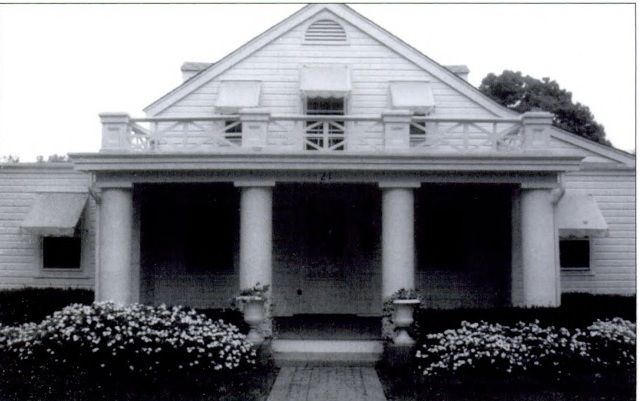
According to the National Register of Historic Places, J.H. Dolph’s summer cottage in Bellport was probably built before 1850 as a carpentry shop where boats and decoys were made. Dolph lived here with his wife Mary and many cats and dogs in the summers from 1875 to 1903.
J.H. Dolph’s country studio was a large square room with high walls covered in gray burlap-canvas and a pointed roof. On the north side was a high studio window and a large wood-burning fireplace. The room had very little furniture, save for an old carved cabinet, a few plain, comfortable chairs, and a couple of tables. Here, the kittens and puppies were free to roll about and play as much as they pleased as Dolph sketched their every move in charcoal.
Because they couldn’t be photographed (they were too fast for the cameras of the time), Dolph and Mary resorted to all kinds of tricks to pose the kittens. He’d put a caterpillar on the floor and sketch the cat while she watched it move slowly across the floor. Sometimes they’d bring in toads or other critters for the cats to watch or play with. Dolph would make a very rough sketch of all the kittens in a group and then he would draw each cat separately.
The sketches, like this one below of dancing kittens, were tacked up all over the walls.
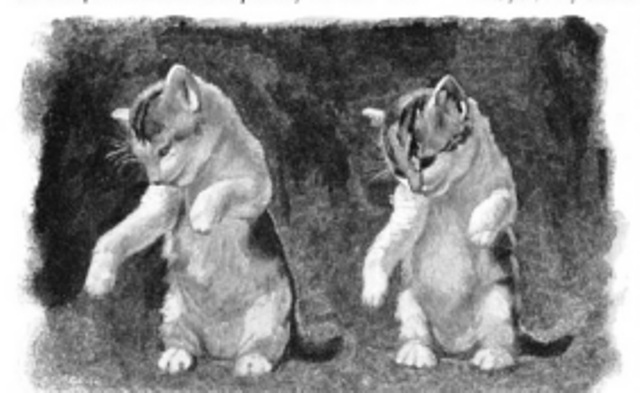 To sketch these dancing kittens, J.H. Dolph had his wife Mary dangle a piece of bread soaked in milk just high above their heads to make them stretch out for it. He was going to call it, “When the mice are away the cats will play.”
To sketch these dancing kittens, J.H. Dolph had his wife Mary dangle a piece of bread soaked in milk just high above their heads to make them stretch out for it. He was going to call it, “When the mice are away the cats will play.”
To further accommodate his models, J.H. Dolph turned his workshop behind the cottage into a cat house, so to speak. He called his workshop the cat’s dormitory.
Sometimes he got more kittens than he knew what to do with, but he always tried to make them all comfortable in the cottage. Once painted, it was always his desire “to find Christian homes” for the cats.
Outside the cottage, Dolph built a raised floor with a grapevine trellis, where he would place his feline and canine models to sketch them as they frolicked in the sun. The floor had a little hole so that if the kittens got scared or a stray dog came by, they could make a quick escape.
Princess and Josephine
“Yes, cats are easily spoiled if you pet them too much, and quickly become your master.”–John Henry Dolph, St. Nicholas, Vol. 18, Part 2, October 1891
Princess was reportedly a very beautiful cat and J.H. Dolph sold many paintings of her. So he made her one of his pets at his summer cottage.
As Dolph told the St. Nicholas in 1891, Princess always sat on his knee when he was eating, and she would only feed from his fingers or eat bits of food put on the table just for her. Soon Princess had her own chair at the table. As Dolph said, she would rather have starved to death – she would never eat anywhere else.
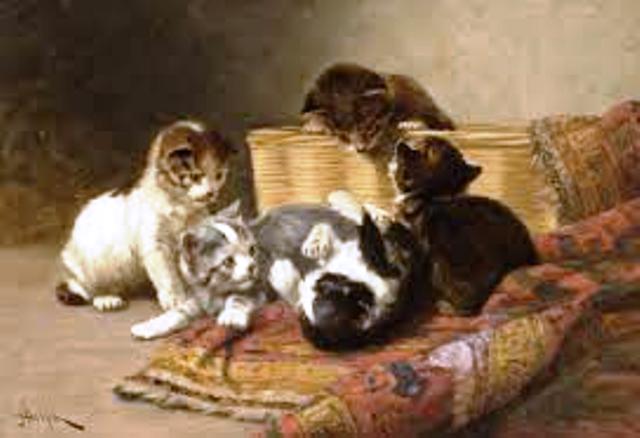 J.H. Dolph, “Playing Kittens”
J.H. Dolph, “Playing Kittens”
J.H. Dolph loved Angoras but he didn’t have many paintings of them because he said they were expensive. (The first cat he painted, in 1875, was what he called a frolicsome Parisian cat, so maybe this was an Angora cat.)
However, he did buy two Angora cats during one of his trips to Paris. One of the cats was shot and killed by someone who mistook him for a skunk in the bushes. The other was Josephine.
Josephine was a huntress who could not be kept indoors at night. She also made a lot of noise outside, angered all the neighbors on Academy Lane. John and Mary would try to find her, but she always stayed quiet until they gave up and turned off the lights. Then she’d begin her nightly chorus.
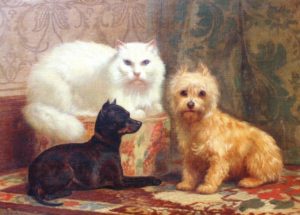
Was this Josephine? Maybe.
One summer Josephine gave birth in the carpenter shop. Her kittens were beautiful, although not pure Angora. When some little neighborhood boys started playing with them, Josephine carried them away to a safe hiding place.
For days she would come to the house for meals, but then run away through the fields. Then one day she brought a dead kitten to the house.
Dolph told the St. Nicholas, “She looked at me beseechingly out of her large, lovely eyes, and licked the kitten all over, and looking at me again with an expression so human that I felt my eyes moisten.”
Each day after that Josephine brought another dead kitten to Dolph, each with a fatal cut in the neck. Apparently she had been keeping them under the barn on the property, and a weasel had gotten to them. Only one kitten survived.
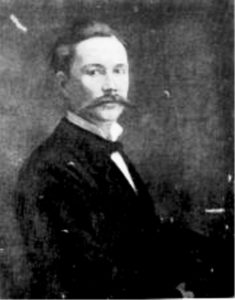
John Henry Dolph’s self portrait
On September 28, 1903, John Henry Dolph died in the apartment of Mrs. Grenner, at 121 West 71st Street, where a funeral service also took place. (Mrs. Grenner was a distant relative who told the press she and Dolph had planned to marry.)
According to The Evening World, Dolph was reportedly sitting in a chair dressed for bed when he succumbed to complications from heart disease. Only a few days before he had sold the cottage at Bellport, Long Island. I don’t know what happened to his cats.
Twenty years later, Mrs. Florence D. Warner, his daughter, donated about 30 paintings to the University of Nebraska – Lincoln. In recent years, Dolph’s paintings have sold for $5,000 or more at art auctions.

Here’s a photo from Google Streets of 21 Academy Lane Bellport as it looks today. I wonder if any Dolph cats still live nearby…



